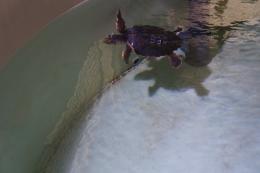Introduction

DCS, or ‘the bends’ is a disease caused by reduction in pressure resulting in N2 gas bubble formation (usually N2 when breathing air) in blood and tissues (also called gas embolism) (Philp 1974).
In air breathing vertebrates, DCS symptoms range in severity from skin rash and tissue distortion to central system disorder, paralysis and respiratory difficulties that reverse during recompression treatment (Philp 1974, Vann et al. 2011).
The common procedure to resolve the bubble formation is to use a recompression treatment with the help of a hyperbaric chamber. The assumption is that the increasing pressure will compress the gas bubbles and force the gas back into solution, which will resolve the existing GE. The recompression is followed by a slow decompression, which helps to safely remove the increased tissue and blood gas burden to avoid bubbles from forming. In a recent study, researchers reported gas emboli (GE) in by-caught loggerhead sea turtles (Carretta carretta) similar to those reported in marine mammals (García-Párraga et al. 2014).
The objective of the present work was to investigate the effect of DCS on lung function in loggerhead sea turtles. For this reason, we performed lung function testing on individuals that arrived at the rehabilitation center (Arca del Mar) located in Spain in Valencia. The rehabilitation center take care of sick or injured animals before releasing them back into the wild. Spirometric testing was performed before and at regular intervals after hyperbaric chamber treatment throughout the recovery. We also assessed the dive durations during the recovery period.
Responsible for this page:
Director of undergraduate studies Biology
Last updated:
04/27/17
